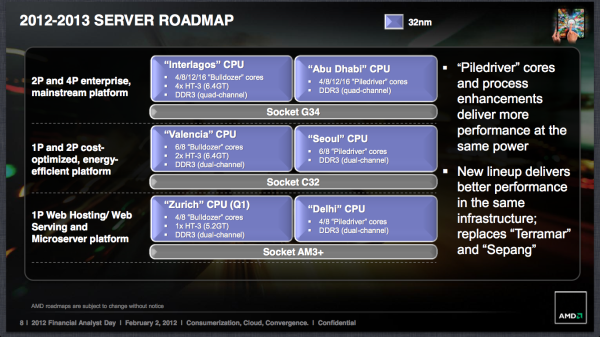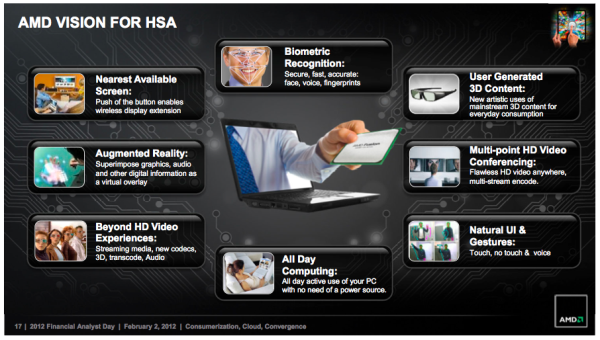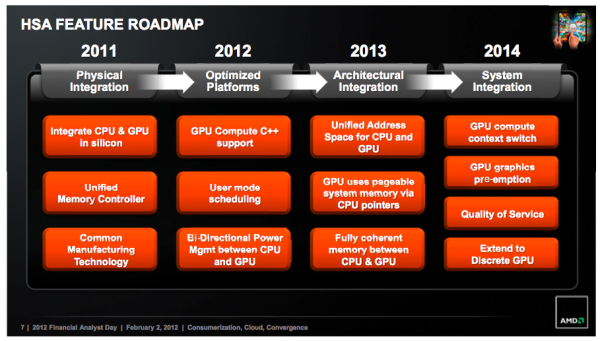Understanding AMD's Roadmap & New Direction
by Anand Lal Shimpi on February 2, 2012 6:16 PM EST- Posted in
- CPUs
- AMD
- Trade Shows
- AMD FAD 2012
The New Focus: Client Mobility
For years we had asked for lower power AMD mobile solutions. While we finally started seeing some progress over the past couple of years, AMD is now very committed to building mobile devices. Anything tablet sized or above is now AMD's target for client APUs.
AMD was always the high-end x86 CPU alternative to Intel in the PC space, now AMD is going to be the alternative in the ultra mobile space.
Servers & the High End Desktop
AMD's server roadmap for the next two years is a bit more conservative. We'll see Piledriver updates from top to bottom but there's no significant departure from the way things are done today. There are no plans for any new sockets in the near term, just using existing platforms to grow AMD's server marketshare without huge new investments.
As AMD's client strategy is predominantly built around APUs, the only high-end desktop parts we'll see from AMD are low-end server CPUs. Socket-AM3+ has a future for one more generation and we'll likely see other single-socket, high-end platforms for the desktop. The days of AMD chasing Intel for the high-end desktop market are done though. That war is officially over.
The Ace: HSA
AMD isn't going to have the fastest general purpose x86 CPUs on the market and it is no longer interested in pursuing that goal. It does promise to have much better on-die GPU performance than Intel. For users today that's primarily an advantage in 3D gaming. As more workloads shift to the GPU however, AMD could have a significant advantage here. The problem is that seamlessly scheduling client workloads across CPUs and GPUs just hasn't happened, the two islands of compute horsepower have remained discrete - even on the new wave of integrated APUs.
AMD's Heterogenous Systems Architecture (HSA) plans to change that. AMD wants to see the creation of a virtual ISA that will be the backbone of a software layer that can schedule application workloads on any combination of underlying CPU/GPU hardware, regardless of the ISA of the hardware. If you have a workload that's best run on big, general purpose x86 cores, that's where it will run. If a task is better designed for highly parallel GPUs cores, it'll run there. And presumably if you had an ARM core somewhere underneath and the workload would run better on it, you'd be covered as well.
AMD plans on delivering an HSA enabled GPU family by 2014, with today's Graphics Core Next GPUs being an intermediary step that already fill a number of these goals. These HSA GPUs would be able to share the same memory space as CPUs and work seamlessly as coprocessors. Granted AMD doesn't have the best track record of quickly moving the industry with things like HSA (although AMD64 did work out quite well), so we'll have to wait and see how all of this plays out.
If AMD can get broad industry support for HSA then its APUs become much more attractive. The overall performance of AMD solutions would then become more compelling as they'd take both CPU and GPU architectures into account, again assuming the workloads require both.













84 Comments
View All Comments
A5 - Thursday, February 2, 2012 - link
The fact that their "enthusiast" desktop CPU will be 32nm through the end of 2013 essentially signals that they are giving up on that market.The Opteron 165 came out 6 years ago - the fact that that is the chip you have to point to is pretty telling, no?
Beenthere - Thursday, February 2, 2012 - link
Sorry but your beliefs are incorrect at this time.I don't have the Opteron 165. It was a reference to prior Opteron success for desktop use.
The point was that AMD is making faster Opterons that use AM3+ sockets. Why would they do this when they already have C32 and G34 sockets?
Look at the roadmap slide carefully with Piledriver, Steamroller and Excavator all bringing ~15% increase each year and fitting into AM3+ sockets. This ain't rocket science.
28 nm will not offer any big gains over 32nm so that's not even an issue. There is diminishing returns with each step to smaller traces. AMD has said they ain't going to push the trace size but instead they will optimise the cores for better performance.
http://www.anandtech.com/show/5488/amds-2012-2013-...
Impulses - Friday, February 3, 2012 - link
I'll never understand blind brand loyalty, specially for CPUs where there isn't much else to take into account besides performance per dollar... At least when it comes to other products the brand loyalists have additional arguments to stand on like build quality, support, reliability, etc.I've had one AMD system, an A64 3000+ Winchester, from the only brief period in history where they were on their game and able to out-execute and out-preform Intel. Every other desktop's been Intel based, they were almost always the smarter purchase. Altho if I was gonna replace my current netbook with another sub-$500 system I'd definitely opt for Brazos right now.
Shifting focus is a smart move for AMD, who cares if a few enthusiasts get butt hurt and a couple others keep hopelessly calling for high end parts? The mobile market's growing faster, it's already larger than the high end desktop market, and enthusiasts & halo products don't drive sales like they used to.
Plus, quite frankly, an Intel dominated mobile market is a heck of a lot scarier than an Intel dominated enthusiast market. Just look at what Intel's been pushing lately, ultrabooks are sexy but they're also a tool to drive the price of the average laptop up... Why do you think Atom hasn't seen a significant redesign by now? Except for Brazos, Intel has effectively been driving laptops upmarket while keeping Atom stagnant to prevent anyone else from eating into their profits.
If Intel dominates the enthusiast market a few of us might suffer a little, but not much because there's little incentive for Intel to suck a shrinking market dry. If Intel dominates mobile, EVERYONE loses.
IlllI - Friday, February 3, 2012 - link
all one has to do is take a look at ARM. they made a massive amount of money last year.mak360 - Friday, February 3, 2012 - link
+1I don`t think i could have said it any better
DanNeely - Friday, February 3, 2012 - link
Because the dual/quad socket C32/G34 parts are inherently more expensive. For 1 socket boxes it's an unneeded additional expense.B-Unit1701 - Friday, February 3, 2012 - link
Are those the same kind of roadmaps that showed Phenom stomping A64? Or Bulldozer way outclassing Phenom? This ain't rocket scinence.I bleed AMD green, but they havent delivered on speed improvement shown on roadmaps in 6+ years, I have a real hard time buying it today.
And your kidding yourself if you think $300 Black Edition CPUs are part of the 'high end' of the market.
silverblue - Saturday, February 4, 2012 - link
Adding 15% extra performance to multithreading would make for an excellent chip indeed, however it's not exactly multithreading where AMD really needs to work its magic, but singlethreading, and let me tell you, adding 15% year on year will POSSIBLY bring them to SB-level singlethreaded IPC by, hmm, 2014? don't need to remind you that Intel aren't going to sit still over this period.Bulldozer may be forward thinking, but there's no arguing that it's a server CPU designed specifically for heavy, multiple workloads, workloads that a lot of people aren't going to see on the desktop. Still, I'd like to see a thorough benchmark of multiple programs at the same time and how Bulldozer handles them. Unfortunately, it won't change the fact that the current architecture has very slow cache, requires very fast RAM to perform decently, isn't exactly the most frugal architecture out there, and bottlenecks graphics cards roughly at the same point that Phenom II did.
Impulses - Thursday, February 2, 2012 - link
" Thankfully, Rory isn't HPing the company. "Is that a new business catchphrase or just Anand's wit?
BitJunkie - Friday, February 3, 2012 - link
It's so funny that tech companies are so far behind other organisations that have "engineering" at their core when it comes to execution. Just because tech is tech doesn't mean these companies can forget everyone else's lessons learned:1) Microsoft with Vista: it was only after their code turned into a complete pile of poorly engineered crap all hacked together by a bunch of mavericks wanting to get an "i made this moment". That they went back to the drawing board and actually started engineering their software and processes. This is not just about the process of coding but the process of designing and engineering and how it is managed. Its about culture.
2) Back in the tech bubble / Vista days, everyone was claiming that you could be a project manager and you didn't need domain experience. Sure, thats true: but not if you want rock solid, fail free and optimised execution. You need to apply project management theory and controls to the process and have someone who can see 10 steps ahead and implement quality decision making taking this stuff into account. Not someone with an over inflated ego with one project cycle under their belt claiming to be gods gift to project management.
Seems to me as though someone has sat down in AMD and realised that nobody is going to invest in their platform if they cant reliably expect the next iteration of their product to arrive on time and with good preformance.
They are adopting a strategy that allows them to execute in a reliable way, but are they going to sort out the process, the systems and the company culture?